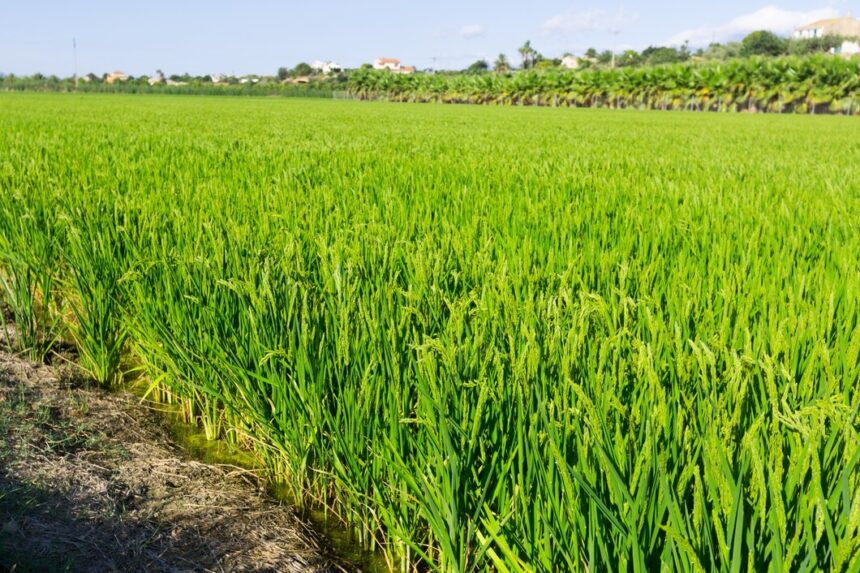Rice farming can be a rewarding endeavor for South African farmers, provided the process is managed with care and precision. This comprehensive guide covers the stages of growing rice, including land preparation, planting, growing, harvesting, and storage, as well as the inputs, machinery, and pest management strategies required.
1. Land Preparation
a. Site Selection: Choose a site with well-drained soil and adequate water supply. Rice thrives in flat or gently sloping areas.
b. Soil Type: Rice grows best in clay or silty loam soils due to their ability to retain water. Ensure the soil pH is between 5.5 and 6.5.
c. Field Preparation:
- Clearing and Tilling: Remove any debris and till the soil to a fine seedbed. Plow the field to a depth of 20-30 cm to break up compacted layers.
- Leveling: Level the field to ensure even water distribution. This can be achieved with a laser leveler or a traditional leveling board.
d. Water Management: Create bunds or levees around the field to retain water. Rice requires consistent water coverage, so ensure that the field can be flooded.
2. Planting
a. Seed Selection: Choose high-quality, disease-resistant rice varieties suited to local conditions. Popular varieties in South Africa include Basmati and Aromatic rice.
b. Seed Treatment: Soak seeds in water for 24-48 hours to promote germination. You may also treat seeds with fungicides to prevent seed-borne diseases.
c. Sowing Methods:
- Direct Seeding: Seeds are sown directly into the field. This method is suitable for dry-seeding or where water control is limited.
- Transplanting: Seedlings are grown in a nursery and then transplanted into the field. This method is common in areas with controlled water supply.
d. Planting Density: Maintain a plant density of 100-150 plants per square meter. For transplanting, space seedlings 20-25 cm apart in rows.
3. Growing
a. Water Management: Maintain a water depth of 5-10 cm during the growing season. Ensure the field is flooded for at least half of the growing period. Drain fields before harvest.
b. Fertilization:
- Pre-Planting: Apply a balanced fertilizer with N-P-K (Nitrogen-Phosphorus-Potassium) before planting.
- Top-Dressing: Apply nitrogen-based fertilizers (urea or ammonium nitrate) 2-3 times during the growing season. Follow local recommendations for quantities and timings.
c. Weeding: Regularly monitor for weeds. Herbicides such as pre-emergent and post-emergent types can be used, depending on the weed species. Common herbicides include glyphosate and propanil.
d. Pest and Disease Management:
- Common Pests: Watch for pests such as rice stem borers and leafhoppers. Use insecticides like chlorpyrifos or imidacloprid if pest populations are high.
- Diseases: Monitor for rice blast, bacterial blight, and sheath rot. Fungicides like carbendazim or mancozeb can control fungal diseases, while bacterial diseases may require copper-based treatments.
4. Harvesting
a. Timing: Harvest rice when the grains reach physiological maturity, and the moisture content is around 20-25%. Grain maturity is indicated by the yellowing of the plant and the hardening of the grains.
b. Harvesting Method:
- Manual Harvesting: Use sickles or scythes for small-scale farms. Cut the rice plants at the base and gather them into bundles.
- Mechanical Harvesting: For larger areas, use combine harvesters to cut and thresh the rice in one operation. Ensure the machinery is well-maintained to avoid losses.
5. Post-Harvest and Storage
a. Drying: After harvesting, dry the rice to reduce moisture content to around 14% to prevent mold and spoilage. Drying can be done using solar dryers, mechanical dryers, or by spreading rice on tarps in a well-ventilated area.
b. Milling: Once dried, the rice is hulled to remove the outer husk. Milling machines can be used for this process.
c. Storage: Store the milled rice in cool, dry conditions in airtight containers to prevent infestations by pests like rice weevils. Ensure proper ventilation in storage areas to maintain quality.
Additional Tips
- Rotation: Practice crop rotation with legumes or other crops to maintain soil health and reduce pest and disease buildup.
- Monitoring: Regularly inspect the crop for signs of stress, pests, and diseases to address issues promptly.
By adhering to these practices and leveraging appropriate inputs and machinery, South African farmers can successfully cultivate rice, achieving high yields and quality while maintaining sustainable farming practices.
Join 'Farmers Mag' WhatsApp Channel
Get the latest Farming news and tips delivered straight to your WhatsApp
CLICK HERE TO JOIN






